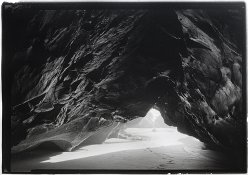Lately I've been working with a 35yo box of old Royal Pan that was described as hopelessly fogged and not responding to light. As you can see, that's very far from the case. Exposure at around 80EI gives pretty good results when developing either normally in D-76, or doing a cold benzotriazole developing in DK-50. Here's an album that shows the kind of results that I'm getting: https://flic.kr/s/aHsmSjZrrM. I think these are pretty acceptable for something that wasn't supposed to work at all.
I guess the thing that bothers me is, I'm not really sure how good my negatives are. I'm not doing any significant twiddling of these images in post at all. I'm just setting gamma to linear, and that's it. Nor am I asking for advice about that. But something bothers me about my negatives, and I don't really have the experience to evaluate them.
For my eyes, they're pretty grey. There seems to be a glow in the shadows. I'm not sure if that's fog or not, or just some stray reflection. This effect seems to have been slightly reduced in the two benzo/cold developed negatives, but maybe not. Maybe I could do better in that respect, but being inexperienced, I'm not sure where to stop.
Where should I start in order to get the most out of the negative? I think I did a reasonable job of picking an EI, and a development time and process that works for it. But is is the best that it can be? Without considering the final images you see here, what objectively would you say just looking at the negatives, and what could be improved upon? Just looking at what you see below, what would you do?
**Note that my goal here is not to use old film because it's cool or great or unobtanium or anything like that. It's to master the processes around taking pictures and developing film. Just manipulating a 4x5 camera takes some practice, and a couple hundred shots will do that.
D76, 7'30", 68F


DK-50 1:1 + benzotriazole, 15', 54F


I guess the thing that bothers me is, I'm not really sure how good my negatives are. I'm not doing any significant twiddling of these images in post at all. I'm just setting gamma to linear, and that's it. Nor am I asking for advice about that. But something bothers me about my negatives, and I don't really have the experience to evaluate them.
For my eyes, they're pretty grey. There seems to be a glow in the shadows. I'm not sure if that's fog or not, or just some stray reflection. This effect seems to have been slightly reduced in the two benzo/cold developed negatives, but maybe not. Maybe I could do better in that respect, but being inexperienced, I'm not sure where to stop.
Where should I start in order to get the most out of the negative? I think I did a reasonable job of picking an EI, and a development time and process that works for it. But is is the best that it can be? Without considering the final images you see here, what objectively would you say just looking at the negatives, and what could be improved upon? Just looking at what you see below, what would you do?
**Note that my goal here is not to use old film because it's cool or great or unobtanium or anything like that. It's to master the processes around taking pictures and developing film. Just manipulating a 4x5 camera takes some practice, and a couple hundred shots will do that.
D76, 7'30", 68F


DK-50 1:1 + benzotriazole, 15', 54F


Last edited:



